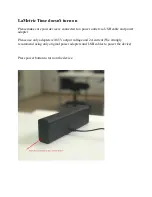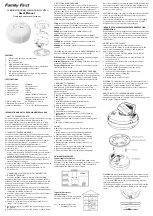
Technical Bulletin
2
SuperDuct Signature Duct Smoke Detector
The duct smoke detector’s primary purpose is to provide early
warning of an impending fire and shut down the HVAC unit in
order to prevent smoke from circulating throughout the
building. It is typically used to detect smoke in the supply side
of the HVAC system but can provide supervision of the return
side as well (see Figure 1.)
Return air
Remote
test
station
Duct smoke
detector
FACP
HVAC unit
Supply air
Duct smoke
detector
HVAC
controls
Remote
test
station
Figure 1: Duct smoke detector application diagram
WARNING:
SuperDuct duct smoke detectors are not intended
as substitutes for open area protection.
In installations where the duct smoke detector’s controls and
indicators are hidden from view, a remote test station or an
LED indicator can be connected to the detector to provide
these functions.
The duct smoke detector is used in conjunction with a
compatible fire alarm control panel and loop controller. The
control panel’s loop controller automatically assigns
addresses. Custom addresses are assigned using a laptop
computer. Address switches are not used.
The duct smoke detector uses differential sensing to prevent
gradual environmental changes from triggering false alarms. A
rapid change in environmental conditions, such as smoke from
a fire, causes the detector to signal an alarm state but dust and
debris accumulated over time does not.
The duct smoke detector issues a dirty sensor warning when it
reaches its preset limit. The dirty sensor warning indicates the
sensor is operating within its specified limits but is in need of
servicing. When the detector’s ability to compensate for
environmental changes has reached its limit, the duct smoke
detector signals a trouble condition.
The duct smoke detector contains a microprocessor capable of
performing comprehensive self-diagnostics and storing the
results. Details such as hours of operation, last maintenance
date, and number of alarms and troubles are stored in
nonvolatile memory. This information can be retrieved and
reviewed when desired.
Air is introduced to the duct smoke detector’s sensing
chamber through a sampling tube that extends into the HVAC
duct and is directed back into the ventilation system through
an exhaust tube. The difference in air pressure between the
two tubes pulls the sampled air through the sensing chamber.
When a sufficient amount of smoke is detected in the sensing
chamber, the duct smoke detector notifies the fire alarm
control panel, etc.
Caution:
Excess temperature differentials between the
ambient air and the sampled air can produce unwanted
condensation inside the detector, which may cause the detector
to function improperly. Precautions should be taken to limit
the temperature range and the amount of condensation to
which the detector is exposed.
Description
The duct smoke detector (see Figure 2) comprises a plastic
housing, a printed circuit board, a clear plastic cover, an
exhaust tube, and a sampling tube. The exhaust tube and
sampling tube are attached during installation. The sampling
tube varies in length depending on the size of the HVAC duct
and is ordered separately.
The clear plastic cover permits visual inspections without
having to disassemble the detector. The cover attaches to the
detector housing using four captive screws and forms an
airtight chamber around the sensing electronics.
Features
The duct smoke detector incorporates the following features:
•
Environmental compensation with differential sensing for
reliable, stable, and drift-free sensitivity
•
Magnet-activated test switch
•
PCB mounted photoelectric detector with onboard
intelligence
•
Cover tamper switch for added security
•
Sampling tube can be installed with or without the cover
in place and can be rotated in 45-degree increments to
ensure proper alignment with duct airflow
•
Alarm and Power status LEDs
•
Standard sampling tube spacing and field connections for
easy drop-in migration from other duct detectors
•
Extended temperature and air velocity ranges
•
One Form C auxiliary alarm relay for controlling ancillary
equipment (e.g., HVAC controls)
• Electronic
addressing
• Self
diagnostics
• Standalone
operation



























